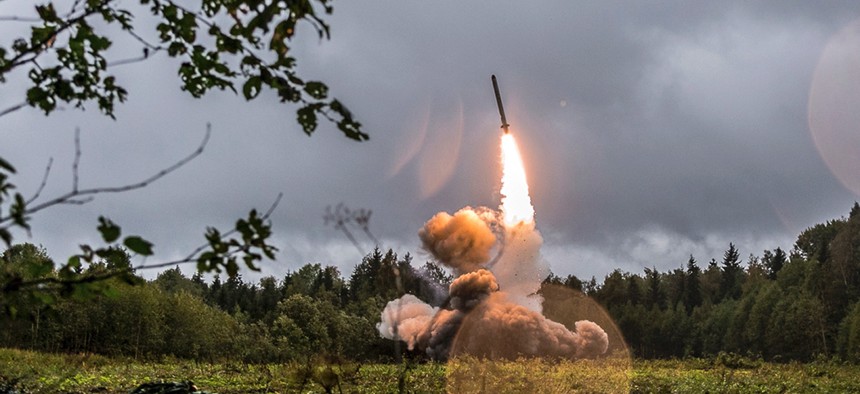
This 2017 photo provided by the Russian Defense Ministry shows a Russian Iskander-K missile launched during a military exercise at a training ground at the Luzhsky Range, near St. Petersburg, Russia. AP / Russian Defense Ministry Press Service
The US Should Accept Russia’s Proposed Moratorium on Post-INF Missiles
The temporary measure has no near-term downside — and may jumpstart important arms-control talks.
Last September, Russian President Vladimir Putin proposed a moratorium on missile deployments in Europe. The Trump administration rejected the idea, and NATO followed suit. But French President Emmanuel Macron and others have since urged President Trump to reconsider. They argue that a moratorium has no near-term downside for the United States — and might help jumpstart productive arms negotiations with Russia.
The proposed freeze would leave Russia with about 100 SSC-8 intermediate-range, ground-launched cruise missiles in Europe. The U.S. government has protested their deployment as a violation of the Intermediate-Range Nuclear Forces Treaty, which banned missiles with ranges between 500 and 5,500 kilometers; indeed, Trump cited them as a reason for scuttling the INF agreement. Yet accepting the moratorium has little downside for the United States. The U.S. currently has no intermediate-range missiles to deploy, and no immediate plans for basing new missiles in Europe. Meanwhile, the Putin government has vowed to deploy no new missiles while its proposal is on the table. If the United States remains cold to the moratorium, however, Moscow could resume the SSC-8 buildup at any moment, increasing the threat to NATO allies and gaining more bargaining chips in future arms negotiations.
The Trump administration has evinced no particular interest in launching such talks with Russia; it has mooted instead the notion of tripartite talks with China, which has thousands of such dual-capable ground-based intermediate-range missiles. Yet it’s far from clear that Beijing has any interest in such talks. Moreover, given that the U.S. has far more nuclear weapons than China, Chinese officials may demand a substantial reduction of those weapons before sitting at the negotiating table.
A new agreement with Moscow, however, has historical precedent, and may generate strategic benefits for the United States and political ones for the Trump administration. While deploying U.S. intermediate-range, ground-launched missiles in Europe may mirror the SSC-8s in a tactical sense, it would not remove their threat to U.S. and allied security. At the moment, NATO allies have not yet expressed support for hosting American missiles, complicating U.S. deployment options. In contrast, arms control may offer an effective way to avoid a potential basing controversy and to stabilize Europe by eliminating the SSC-8s.
Related: Trump’s Bid to Go Big on Nuclear Arms Looks Like a Fizzle
Related: Where Could the U.S. Put Its Post-INF Missiles?
Related: Europe Has No Attractive Options in the Post-INF World
The Trump administration might also reap political benefits from commencing disarmament talks about the SSC-8 during an election year. If the Putin government is serious about arms control, U.S. officials may be presented with another opportunity to replace an aging agreement with a signature accord that may resonate with American voters. NATO allies, too, might express support for meaningful U.S.-Russian arms control talk, which may aid President Trump in the coming months, when Democratic candidates, such as former Vice-President Joe Biden, might continue lambasting his policies in Europe. By embracing the moratorium, the Trump administration would also retain the prerogative to pursue trilateral talks with Russia and China, if the gambit proves unfruitful.
Once the Trump administration is convinced of the value of such talks, American officials could secure Russia’s participation by publicly considering further developing a new generation of intermediate-range missiles, without direct deployment. The U.S. could seek European allies, such as Poland, to agree in principle to host the weapons if deployment should be needed. It is the threat of American missile deployments in Europe that might compel the Putin government to engage in fruitful arms talks. But U.S. weapons might never have to be deployed if the mere threat of American missile development forces Russian negotiators to the table and an agreement is reached.
To make a potential accord more palatable to the Kremlin, U.S. officials could make a further proposal that would confine the agreement to Europe proper, allowing Moscow to station missiles east of the Ural Mountains. If Russia violated the accord by moving, say, mobile SSC-8s to Europe itself, U.S. officials could respond by deploying additional sea-based and air-launched systems to the continent. Plus, a treaty limited to Europe would preserve American bargaining leverage in Asia, where U.S. negotiators may need intermediate-range missiles to balance thousands of dual-capable Chinese systems.
The U.S. already has the wares to showcase its bargaining power: On Aug. 18, the Pentagon tested a ground-launched, intermediate-range cruise missile, its first since the end of the Cold War. That was followed by a ground-launched, intermediate-range ballistic missile test on Dec. 12.
The Trump administration may well continue its testing of intermediate-range missiles until the Putin government proves forthcoming in arms control negotiations. The U.S threat of deployment may prove an effective safeguard against a destabilizing arms race in Europe.




